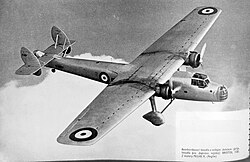Bristol Bombay
| Bristol Bombay | |
|---|---|

|
|
| Type: | Bomber , transport plane |
| Design country: | |
| Manufacturer: | |
| First flight: |
June 23, 1935 |
| Commissioning: |
1939 |
| Production time: |
1939 |
| Number of pieces: |
51 |
The Bristol 130 Bombay was a twin-engine bomb and transport aircraft of the Royal Air Force (RAF) in all-metal construction.
History and construction
The Bristol Bombay was designed in 1931 on the basis of a tender by the British Aviation Department for a transport aircraft for 24 soldiers and made its first flight in 1935. 50 copies were made and used by the RAF from 1939, although they were already out of date by that time (among other things because of the fixed, non-retractable landing gear). In the Mediterranean region, the machine was used as a transport aircraft in the early phase of World War II , in North Africa it was sometimes used for night-time bombardments.
Trivia
- The Greek royal family was named No. 2 with Bristol Bombay on May 2, 1941. 216 Squadron flown from Crete to Egypt.
- Five Bristol Bombay were used by the British SAS in their first commando operation in the Middle East (target were German field airfields).
- Lieutenant-General William Gott died when a Bristol Bombay carrying him was shot down over the Libyan desert on August 7, 1942 . He was the highest ranking British officer who died in World War II. His death resulted in Bernard Montgomery's command to Africa.
variants
- Type 130 - prototype
- Type 130A - Bombay Mk I: twin-engined medium-weight bomber and transport aircraft. Originally referred to as the Type 130 Mark II .
- Type 137 - Projected civil transport aircraft, not built.
- Type 144 - Proposed version with retractable landing gear, not built.
Military use
Technical specifications
| Parameter | Data |
|---|---|
| crew | 3-4 |
| length | 21.1 m |
| span | 29.22 m |
| height | 6.1 m |
| Wing area | 124.5 m² |
| Wing extension | 6.9 |
| Max. Takeoff mass | 9173 kg |
| Top speed | approx. 309 km / h at 2000 m (6500 feet ) altitude |
| Cruising speed | approx. 270 km / h at an altitude of 3050 m |
| Range | 1415 km, with additional fuel approx. 3560 km |
| Armament | two Vickers K machine guns in bow and stern turrets; 908 kg (2000 lb) bombs spread over eight 113 kg (250 lb) bombs carried under the fuselage |
| Engines | two radial engines Bristol Pegasus XXII with 753 kW (1024 PS) each |
See also
literature
- B. Gunston: Classic World War II Aircraft Cutaways. Osprey, 1995, ISBN 1-85532-526-8 .
- Kenneth Munson (Ed.): The World War II Planes. All planes of the warring powers. Motorbuch Verlag, Stuttgart 1972 (12th edition from 1983), ISBN 3-87943-302-X .
Web links
Commons : Bristol Bombay - collection of pictures, videos and audio files
Individual evidence
- ↑ a b C.H. Barnes: Bristol Aircraft Since 1910. Putnam, 1964, ISBN 0-370-00015-3 .